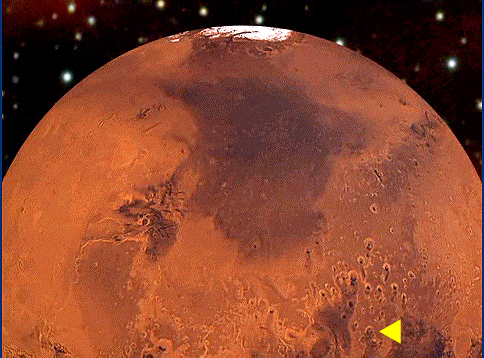
Andrew Claude de la Cherois Crommelin (1865 - 1939)
British Astronomer
Return / Terug

A. C. Crommelin was born in Cushendum, Co. Antrim, Ireland, on 6 February 1865. He was assistant at the Royal Greenwich Observatory between 1891 and 1927.
Crommelin died on 20 September 1939. Obituaries are in Mon. Not. RAS 100 (1939/40), p. 234-26 and in Ciel et Terre 56 (1940), p. 166-68


Download Mars Map (.pdf file)

Mars, Enhanced Visible Spectrum

Now that you know where Crommelin Crater is located,
try to find it in this Mars Animation by Neal Adams.







Neal Adams' "Growing Planet" TheoryThese pictures of Crommelin Crater may support Neal Adams' contention that Mars is "Growing" or expanding as new material being created within the interior of astral bodies wells up to the surface and causes 'continents' to drift away from each other. The physical process behind this "growing planet" theory is not well understood, but some plausible theories now exist. Here is how the "Growing Planet" model would look when applied to our Earth.
|


Figure 12a shows Crommelin crater, in western Arabia Terra that was chosen by Malin and Edgett as an excellent example of exhumed sedimentary layers. Remarkably, there are essentially no visible impact craters superimposed on the exhumed terrain. The fact that strata edges are well exposed indicates that superposed, fresh-looking impact craters would date the time since exhumation, not the time since the last mantling deposition (because recently deposited mantles would be draped over all the terrain and blanket strata edges). While the lack of craters demolishes the chance for a statistically meaningful fit of crater counts to an isochron, it puts an upper limit on the age – not of the bedrock layers (which may be much earlier) but of the of the exhumation process. As shown in Fig. 12b, this upper limit is in the range of 0.1 to a few Ma, depending on how much we trust the isochrons for the smallest craters. This result gives a good counter-example to Malin and Edgett (2003), who assert that the exhumation process makes crater-count chronologic interpretation impossible. On the contrary, a careful examination of exhumed surfaces should give information about the chronology of the exhumation process itself.

(a) Dramatic stratified terrain in crater Crommelin, showing a virtual absence of visible craters post-dating the exhumed surface. 8N, 7W, M14-01647. (b) Crater counts on the exhumed terrain give only upper limits, suggesting very young ages within the last few Ma for the exhumation process.
As discussed by Berman et al. (submitted), a characteristic age of a few Ma to a few tens Ma is also found for possible ice flow features and gullied hillsides at moderate-to-high latitudes. These results, taken together, suggest the important result that recent exhumation (and ice deposition) processes may operate on a timescale comparable to the last few high obliquity excursions (5 Ma, 20 Ma), and may be associated with subaerial deposition and later wind-removal of the ice-rich dust mantles proposed by Mustard et al. (2001)and Costard et al. (2002). This raises the important question, for future investigation, of the extent to which axial tilt, in the last 4 to 30 Ma, has affected decameter topography and crater preservation at low latitudes, as well as moderate and high latitudes.
